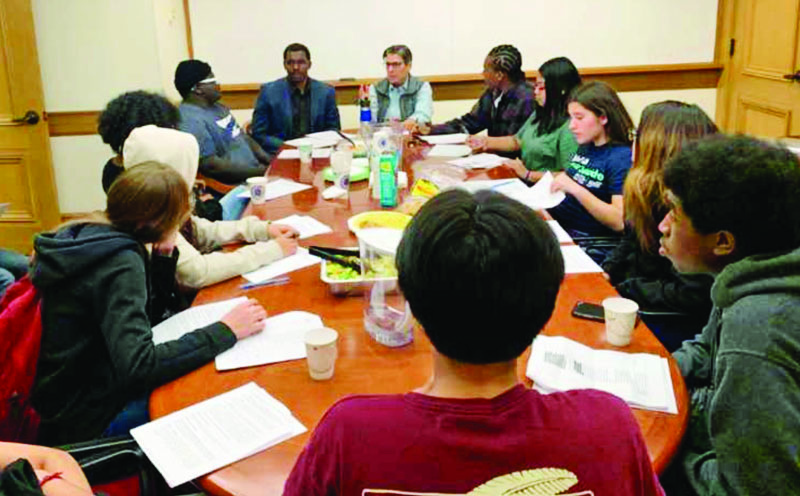Bay Area
City Council Places Oakland Youth Vote Measure on November Ballot

The Oakland City Council voted unanimously at its Tuesday meeting to place an Oakland Youth Vote measure on the November ballot, which would give 16 and 17-year-olds the right to vote in Board of Education elections.
If the measure is approved, Oakland would become the sixth city in the country to extend the voting age to 16. Berkeley passed a similar measure in 2016 and San Francisco is attempting to do the same in November.
“Allowing young adults to have a vote in elections directly impacting them helps improve the responsiveness of these governmental roles, and helps build empowered community members, with practical knowledge and skillset to make a change in their community through the democratic process,” said Council President Rebecca Kaplan, who introduced the ballot measure to add an amendment to the Charter of the City of Oakland.
“In this era, as we face down threats of voter suppression and other efforts to silence marginalized voices in our democracy, it is all the more important that we work to ensure our communities are included,” she said.
Kaplan emphasized that many youth organizations and others on the City Council have joined together to support the measure.
“The young people have been working on this for a long time and have done incredible work,” she said. “I was honored to bring this forward with them and then to be joined also by Councilmembers (Nikki) Bas, (Loren) Taylor, and (Sheng) Thao.”
Student leaders from Oakland Kids First, All City Council Student Union, and organizations from the Oakland Youth Vote Coalition launched Oakland Youth Vote to strengthen youth voices and expand their role in improving the education system. They spent months researching, engaging their school communities, and meeting with community leaders to enlist their support in the development of the legislation.
“Research has proven that younger, first-time voters are more likely to become life-long voters and make our parents more likely to vote as well. This will help us get more youth and young adults more civically engaged” said Denilson Garibo, Oakland school board student director.
“This is important to me because I’m a student in the Oakland Unified School District and anything that’s going to affect my school system, is going to affect me and my future,” said Ixchel Arista, a student organizer with Oakland Kids First.
Keith Brown, president of Oakland Education Association (OEA), is also backing the measure.
“The reality is that budget cuts and slashing critical student services hurt students, particularly low-income students of color,” he said. “Students led the fight to protect many of those services. They have a right to help choose School Board representatives who put students first.”
For more information and to see full list of supporters, go to: www.oaklandyouthvote.org
Activism
Oakland Post: Week of May 21 – 27, 2025
The printed Weekly Edition of the Oakland Post: Week of May 21 – 27, 2025

To enlarge your view of this issue, use the slider, magnifying glass icon or full page icon in the lower right corner of the browser window.
Bay Area
Chevron Richmond Installs Baker Hughes Flare.IQ, Real-time Flare Monitoring, Control and Reduction System
While the sight of flaring can cause concern in the community, flares are essential safety systems that burn pollutants to prevent them from being released directly into the atmosphere. They activate during startup and shut-down of facility units or during upsets or equipment malfunctions. The typical flare stack is about 200 feet high so that vapors are well above street levels.

The Richmond Standard
Chevron Richmond recently installed flare.IQ, a real-time, automated system that will improve the facility’s flaring performance.
The technology, developed by Panametrics, a Baker Hughes business, uses sensors to monitor, reduce and control flaring in real time. It collects and assesses data on refinery processes, such as temperature, pressure, gas flow and gas composition, and adjusts accordingly to ensure flares burn more efficiently and cleanly, leading to fewer emissions.
“The cleaner the flare, the brighter the flame can look,” said Duy Nguyen, a Chevron Richmond flaring specialist. “If you see a brighter flame than usual on a flare, that actually means flare.IQ is operating as intended.”
While the sight of flaring can cause concern in the community, flares are essential safety systems that burn pollutants to prevent them from being released directly into the atmosphere. They activate during startup and shut-down of facility units or during upsets or equipment malfunctions. The typical flare stack is about 200 feet high so that vapors are well above street levels.
“A key element in Baker Hughes’ emissions abatement portfolio, flare.IQ has a proven track record in optimizing flare operations and significantly reducing emissions,” said Colin Hehir, vice president of Panametrics, a Baker Hughes business. “By partnering with Chevron Richmond, one of the first operators in North America to adopt flare.IQ, we are looking forward to enhancing the plant’s flaring operations.”
The installation of flare.IQ is part of a broader and ongoing effort by Chevron Richmond to improve flare performance, particularly in response to increased events after the new, more efficient hydrogen plant was brought online in 2019.
Since then, the company has invested $25 million — and counting — into flare minimization. As part of the effort, a multidisciplinary refinery team was formed to find and implement ways to improve operational reliability and ultimately reduce flaring. Operators and other employees involved in management of flares and flare gas recovery systems undergo new training.
“It is important to me that the community knows we are working hard to lower emissions and improve our flaring performance,” Nguyen said.
Also evolving is the process by which community members are notified of flaring incidents. The Community Warning System (CWS), operated by Contra Costa County is an “all-hazard” public warning system.
Residents can opt-in to receive alerts via text, e-mail and landline. The CWS was recently expanded to enable residents to receive notifications for “Level 1” incidents, which are considered informational as they do not require any community action.
For more information related to these topics, check out the resources included on the Chevron Richmond, CAER and Contra Costa Health websites. Residents are also encouraged to follow @chevronrichmond and @RFDCAOnline on Facebook and X (formerly Twitter), where additional information may be posted during an incident.
Activism
Oakland Hosts Town Hall Addressing Lead Hazards in City Housing
According to the city, there are 22,000 households in need of services for lead issues, most in predominantly low-income or Black and Latino neighborhoods, but only 550 to 600 homes are addressed every year. The city is hoping to use part of the multimillion-dollar settlement to increase the number of households served each year.

By Magaly Muñoz
The City of Oakland’s Housing and Community Development Department hosted a town hall in the Fruitvale to discuss the efforts being undertaken to remove lead primarily found in housing in East and West Oakland.
In 2021, the city was awarded $14 million out of a $24 million legal settlement from a lawsuit against paint distributors for selling lead-based paint that has affected hundreds of families in Oakland and Alameda County. The funding is intended to be used for lead poisoning reduction and prevention services in paint only, not water or other sources as has been found recently in schools across the city.
The settlement can be used for developing or enhancing programs that abate lead-based paint, providing services to individuals, particularly exposed children, educating the public about hazards caused by lead paint, and covering attorney’s fees incurred in pursuing litigation.
According to the city, there are 22,000 households in need of services for lead issues, most in predominantly low-income or Black and Latino neighborhoods, but only 550 to 600 homes are addressed every year. The city is hoping to use part of the multimillion-dollar settlement to increase the number of households served each year.
Most of the homes affected were built prior to 1978, and 12,000 of these homes are considered to be at high risk for lead poisoning.
City councilmember Noel Gallo, who represents a few of the lead-affected Census tracts, said the majority of the poisoned kids and families are coming directly from neighborhoods like the Fruitvale.
“When you look at the [kids being admitted] at the children’s hospital, they’re coming from this community,” Gallo said at the town hall.
In order to eventually rid the highest impacted homes of lead poisoning, the city intends to create programs and activities such as lead-based paint inspections and assessments, full abatement designed to permanently eliminate lead-based paint, or partial abatement for repairs, painting, and specialized cleaning meant for temporary reduction of hazards.
In feedback for what the city could implement in their programming, residents in attendance of the event said they want more accessibility to resources, like blood testing, and information from officials about lead poisoning symptoms, hotlines for assistance, and updates on the reduction of lead in their communities.
Attendees also asked how they’d know where they are on the prioritization list and what would be done to address lead in the water found at several school sites in Oakland last year.
City staff said there will be a follow-up event to gather more community input for programming in August, with finalizations happening in the fall and a pilot launch in early 2026.
-

 Activism4 weeks ago
Activism4 weeks agoAI Is Reshaping Black Healthcare: Promise, Peril, and the Push for Improved Results in California
-

 Activism4 weeks ago
Activism4 weeks agoBarbara Lee Accepts Victory With “Responsibility, Humility and Love”
-

 Activism4 weeks ago
Activism4 weeks agoESSAY: Technology and Medicine, a Primary Care Point of View
-

 Activism4 weeks ago
Activism4 weeks agoFaces Around the Bay: Author Karen Lewis Took the ‘Detour to Straight Street’
-

 Arts and Culture4 weeks ago
Arts and Culture4 weeks agoBOOK REVIEW: Love, Rita: An American Story of Sisterhood, Joy, Loss, and Legacy
-

 Activism4 weeks ago
Activism4 weeks agoNewsom Fights Back as AmeriCorps Shutdown Threatens Vital Services in Black Communities
-

 #NNPA BlackPress4 weeks ago
#NNPA BlackPress4 weeks agoThe RESISTANCE – FREEDOM NOW
-

 Activism4 weeks ago
Activism4 weeks agoTeachers’ Union Thanks Supt. Johnson-Trammell for Service to Schools and Community














































